12/01/07 Solo Practice
1.3 hours today
(Solo)
55.6 hours total (42.2 Dual, 13.4 Solo)
Due to the Thanksgiving holiday, I didn't get a chance to
get out to the airport until Sunday afternoon. My main goal on that trip
was to clean the interior of the plane, since it was pretty grimy. I was
hoping to take the plane up for a flight once I got the interior clean,
but it took longer to clean the plane than I thought it would, so no
flying on Sunday. The interior cleaned up nice, though.
So the next
time I could go up flying was today. First, though, I had to change the
battery in the ELT (Emergency Locating Transmitter). It is supposed to go
off if you crash to help rescuers find you. It's track record is not too
great, however, as usually in a crash the antenna is damaged. This
dramatically reduces the range in which it transmits. But, it is required
by the FAA, and the battery must be replaced every two years. This one was
actually three years old, so apparently, the previous owner was flying
without a current ELT.
Replacing the battery was pretty easy,
except for the fact it is located in the back of the baggage compartment
behind a plastic panel. Getting the panel out was easy, but removing the
ELT from the bracket required me to lay down the length of the plane to
reach it. Once I removed it, it only took five minutes to replace the
battery. All told, it took about 45 minutes to remove the ELT, replace the
battery, and re-install it.
There was still plenty of daylight left
today, so once everything was buttoned up, I took the plane out to the
practice area. This would be my first time up alone in my new
plane.
It was a nice day, and there were a lot of people out
flying. I had two planes in front of me to take off. That is pretty
unusual, since I can almost always take off as soon as I am ready. I took
off and headed west to the practice area.
Since my last flight in
98M, I looked into any prop restrictions. Someone had told me there was an
engine rpm that you couldn't cruise in, so I had been taking it easy with
the throttle until I could confirm exactly what the restrictions were. As
it turns out, there are no restrictions at all, other than keeping the
rpms below the red line on the tach. By running the prop at full throttle,
the plane cruised along at 90 knots. This is the same as the other 152 I
had been flying.
Once I got to the practice area, I started working
my way through the flight maneuvers. First was slow flight. Usually, this
is done with flaps, but since my flaps were inop, I did the slow flight
"clean". This is also an acceptable way to fly the maneuver. That went
pretty well, so I transitioned into a power off stall. This time I did not
mess around with the yoke. I just firmly pulled it back and forced the
stall. The plane stalled and I recovered without any issues. I don't think
I have any more issues with stalls.
Next, I did a power on stall. I
pushed the throttle all the way in and pulled back on the yoke. On the
power on stall, you have to put a little more effort into holding back the
yoke, but it also went without a problem.
After that, I wanted to
practice steep turns. The first one around was not very good. I
wasn't holding my altitude properly. I do steep turns to the left
first, and then to the right. I don't know why, but I like doing them that
way. By the time I got around both directions, I had the plane
trimmed up pretty well. Since the first try wasn't very good, I did
them again. This time, they were within the standard. The key to
them, I think, is getting the plane set up properly before you
start.
Once I was done with them, I noticed a plane going south
through the practice area the same altitude as me. He was a couple
miles away, and I was surprised that I wasn't really bothered by it
this time. I started to descend anyway, since my next maneuvers are done
at 600-1000 feet AGL. Once I got down to that altitude, I practiced turns
around a point.
Initially, I had problems with this maneuver, but
eventually I got the plane trimmed properly where I didn't lose any
altitude. I will have to remember for my checkride to slow down and
make sure the plane is flying the way I like it before starting a
maneuver. Then I did S-turns across a road, and those went
pretty well, since it really is the same thing as turns around a
point.
After that, I decided to head back. I could have stayed out
there longer, but I had accomplished everything I wanted to. I climbed
back up to 1000 feet and headed for the airport. There was a lot of
traffic around the airport, with almost constant position calls from the
other planes. At one point, a business plane got on the radio to the FBO
and had a five minute discussion with them about luggage and rental cars
for their passengers. Finally, the FBO told them to move to the
FBO-specific frequency. As soon as he stopped talking everyone made
position reports.
During this time, I made my report, and then I
hear on the radio, "Where did you say you were, John?" That was the first
time anyone ever called my by name on the radio, and I wasn't sure if they
were talking to me, or what I should say! Finally, I just gave another
position report. Then I realized it was Mike in another plane with a
student. Later, I saw him and asked him if he called me, and he said he
did. Apparently, someone stepped on my transmission.
I brought the
plane in for a landing, and did a pretty good landing. I have been flaring
too high above the runway lately, and am trying to force myself to bring
the plane closer to the ground. So this once was much better. I did,
though, hear the same noise as before once the wheels hit the ground. I am
not going to do many landings until that gets looked at. I also noticed
that it seems to take more power to get the plane rolling than on 41H. At
first, I thought it was the brakes, but now I think it is the wheel
bearings. I will have the A&P look at it next week.
I do have
to say that I am feeling much more comfortable in the plane, and with my
flying. After my last lesson with Mike, I felt that I needed lots of
practice with the maneuver. But after today, I am pretty sure I can do
them if I get everything set correctly before I start them. I still need
to practice all the landings, but not until the flap motor is
fixed.
Tomorrow I am going to wash and wax the plane. I'm not sure
how long that is going to take, so I don't know if I will get to fly
tomorrow. Also, my new carpet did not show up this week, but will be here
next Monday. I think I will take a vacation day and install it next week.
I need to get this plane on the flight line and starting to generate some
income. But, today was my absolute cheapest hour of flying. All it cost me
was gas, which I had already paid for last time. No instructor fees or
anything. Nice! 
12/15/07 Some Landing Practice
0.7 hours today
(Solo)
56.3 hours total (42.2 Dual, 14.1 Solo)
OK, I know it has been a while since my last update. It
hasn't been because I haven't been doing anything, just that I haven't
been doing any flying. Since this is a blog about learning to fly, not
working on a plane, I am only updating it when I am flying. What I have
been doing, instead of flying, is getting my plane ready to
rent.
The day after my last flight I was going to wash and wax the
plane and then go up for a quick flight. Well, it took all afternoon to
finish, and there wasn't enough daylight left.
Since I had some
extra vacation days I needed to use up this month, I have been taking
Fridays off during December. After my last flight, my plan was to work on
the plane the following Friday and Saturday, and then fly on Sunday. Well,
it didn't work out like that at all. The good news was that Gary, the
A&P (Airframe and Powerplant) mechanic, was back from his Thanksgiving
vacation and available to work on my plane. He ordered all the parts
during the week, and was ready for my assistance on Friday.
My plan
was to get the old carpet out of the plane on Friday and help Gary with
whatever I could. First, I removed one of the main landing gear wheels and
removed the bearings. They looked fine, so we just soaked the old grease
out of them and re-greased them. Next, I pulled out the seats and the old
carpet. Then I scraped the carpet off of the kick panels and glued the new
carpet on them.
Meanwhile, Gary was installing the new flap motor.
It was a little difficult to get out, and when he finally got it out, the
date on it indicated it was the original flap motor. If I get another 27
years out of the new one, I will have done alright! He also checked how
tight the cables for the ailerons were. They were at least twice as tight
as they should have been. He fixed that and they were much better.
Gary also serviced the nosegear strut. It had two main problems.
First, the tierods that control the movement of the nosewheel when you are
on the ground were loose and needed to be shimmed. Second, the strut is
supposed to have some hydraulic oil with pressurized air over it. The
hydraulic fluid absorbs the shock of landing, and the air extends the
strut when you are in the air to lock the wheel in place so it doesn't
turn when you are flying. Well, there was no air in the strut at all, it
was completely filled with hydraulic fluid. Gary had to drain some of the
oil out and add nitrogen to the strut.
Saturday, Gary wanted to go
see the space shuttle launch, so all I did was prepare the new intercom
for installation. We were a little short on wire, so I had to scrounge
around the hangar to find enough. I was going to build the wiring harness,
but I wasn't sure we had enough wire to finish, so I waited until Sunday
so Gary could help me get the wires the exact length.
Sunday, once
we measured the wires, I soldered the pins for the connector on to the
wire and put them in the connector. Then I ran the wires through the
plane. Meanwhile, Gary mounted the intercom and made some backing plates
for the headset jack housings. Gary also installed the new sending unit
for the inoperative gas gauge in the right tank. And that was pretty much
the end of Sunday, so no flying that weekend.
Monday after work, I
went back to the airport to finish the intercom installation. I soldered
the jacks on to the wires for the headsets, and soldered the wires that
tied the intercom into the radios. During the day, Gary had connected all
the push to talk (PTT) switches and the power to the intercom. Once I was
done, I tested the intercom. Everything appeared to be working. I couldn't
test the transmit function, since it was 10:30 pm by then, and there
wasn't any other airplanes at the field to talk to.
The next Friday
(12/14), I also had the day off. I went to the airport to try and finish
the plane. Gary was there, and he did the other wheel bearing we hadn't
done while I started to put the carpet in. We had taken a lot of the
interior pieces out to work on the plane, so I had to put them in first.
Then I started to put the new carpet in. By the time I finished, it was
5:00 pm, and too late to fly. But the plane was finally back together, so
I could fly it on Saturday.
I got out to the airport around noon.
SunQuest has free lunch every Saturday, so I went and ate lunch first.
Then I headed out to the plane. I did a really thorough pre-flight, since
we had messed with a lot of pieces over the last few weeks. Everything
looked good, so I was finally ready to fly again. I started the plane up
and did a radio check. No one could hear me. D'oh! The one thing I didn't
test! I shut the plane down and got the key to the hangar so I could
troubleshoot the problem. It turned out to be the wire that went from the
intercom to the radio. It took about two hours to troubleshoot and fix the
problem. Finally I was ready to fly, for real this time.
I did
another radio check, and everything worked this time. The wind was out of
the south, and the hangars are on the north end of the field, I was
already on the correct end of the runway. I did a good run-up, and
everything check out. I took the runway and launched.
My plan was
to just stay in the pattern in case there were any more problems. Plus, I
needed to practice all the different types of landings. I went around the
pattern, and came in for a landing. As I was flying in on final, I noticed
the winds were pretty gusty. I landed the plane fine, but it wasn't
pretty. In fact, instead of doing a touch-and-go like I had planned, I
exited the runway. I was contemplating going back in, but I decided that
the winds weren't that gusty, and I was probably more rusty than
anything else. So I taxiied back and took off again.
This time
around, it was better. I think on the first landing, I had mis-judged
where the wind was blowing, and didn't have a very good crosswind
correction in. This time my landing was acceptable, so I put the throttle
in and took back off. I still had my flaps out when I took off, but I
noticed it right away and retracted them. Another problem from being
rusty.
The third time around, my landing was a little better, but I
decided that it really was pretty gusty out, or maybe the wind was picking
up. Either way, I decided not to press my luck and taxiied back to the
ramp. All-in-all, it was a successful flight, but it was a little too
gusty to practice short field and soft field landings. That was what I
really needed to practice, so that will have to wait until next
time.
I am planning on coming out tomorrow. It is supposed to be
windy, so I may not fly. If not, there are a few little details on the
plane I need to finish up so I can start renting it. I have spent a lot of
money on the repairs, and I need to start getting it back.
Here are
a few pictures of the work I did on the plane (that you can see):
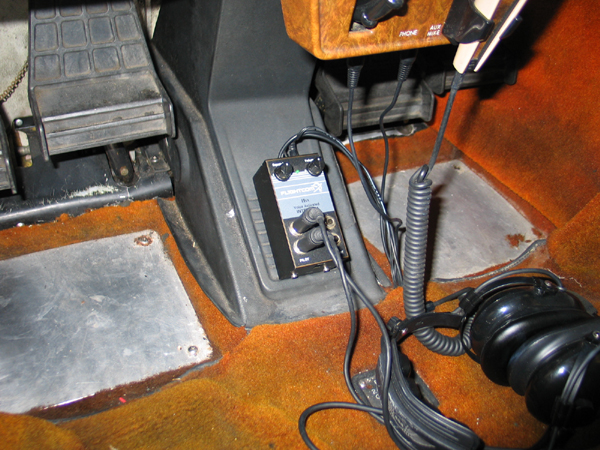
Here is the ugly carpet before (and the old
intercom).
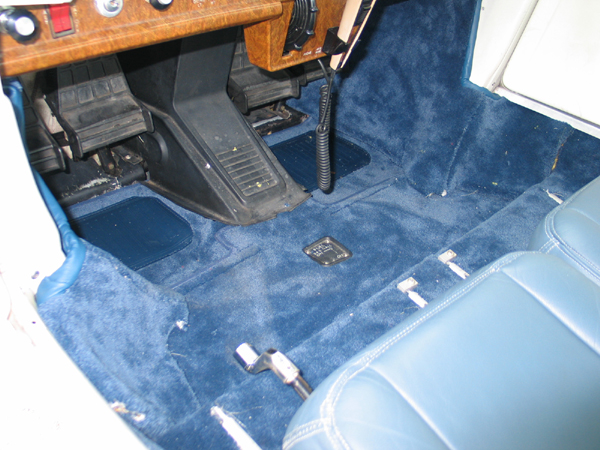
Here it is after. Very Nice!
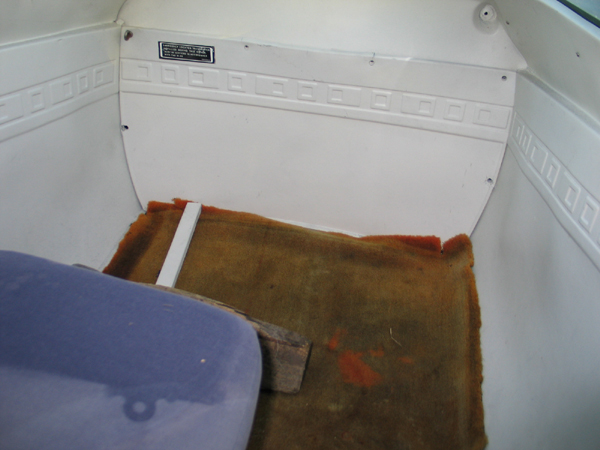
Here is the baggage area
before.
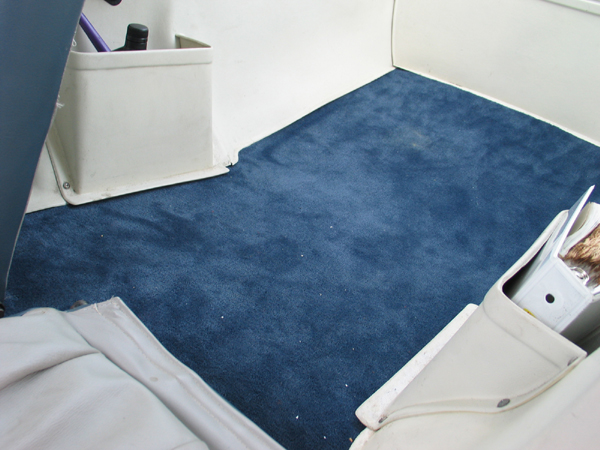
Here is the baggage area after. Sorry the shots aren't from
the same angle.
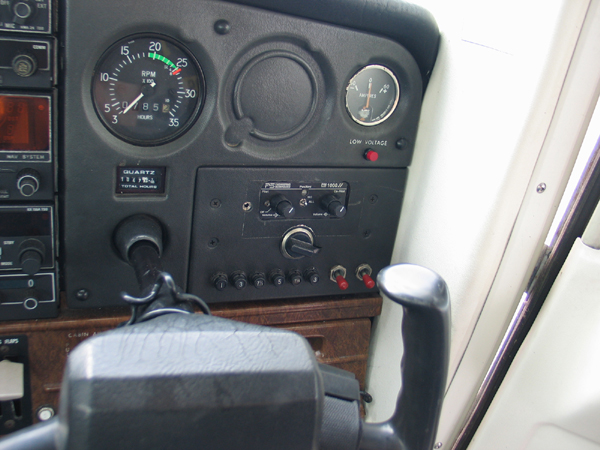
Finally, here is the new intercom.
My next flight will hopefully be tomorrow. If not, I have
next Friday off from work. 
12/21/07 Practice
1.2 hours today
(Solo)
57.5 hours total (42.2 Dual, 15.3 Solo)
Well, it turned out to be too windy last Sunday to fly, so I
just installed a few missing placards in the plane. I also signed the
contract with SunQuest for my plane rental, so it is now officially on the
flight line.
I had the day off work today (actually for the rest of
the month, now), so I wanted to get an hour or so of flying in before I
leave for Conneticut for Christmas. I also wanted to go out to the airport
and see how much my plane had been flying. My plan for today was to go to
the practice area and practice the manuevers, and then back to the airport
for some landing practice. Mike is already on vacation the rest of the
month, so I will be flying solo until he comes back.
When I got to
the airport, I saw that Mike had taken a couple students out in my plane
for about two hours this week. Not great, but it is something. I am not
anticipating much activity on the plane the rest of this month due to the
holidays and the fact most of the instructors are not working between
Christmas and New Years.
I grabbed the book and went out to
pre-flight the plane. Quite a bit of water in the gascolator this morning.
We have had a few showers, so I am thinking that maybe one of the gaskets
on the fuel caps needs to be replaced. I'll keep watching it to see if it
is something I need to take care of. I drained the water out of the
gascolator and the tanks, and finished my pre-flight. Everything looked
good.
The winds were out of the west today at about 8 knots, so I
would be using runway 26L. I took off and continued west to the practice
area. As I approached the cane fields, the visibility started to drop. At
first I thought it was the cloud deck lowering, but once I got close, I
realized it was the smoke from the cane fields that was causing the
problem. The wind was blowing the smoke towards the east today. Usually,
it is going in a different direction. I turned north and got out of the
way of the smoke. Once north of where they were burning the fields, the
visibility was fine.
First, I practiced slow flight with the flaps.
This is the first time I had done this in a while, since the flap motor
wasn't working until last week. Slow flight with the flaps down is much
easier. I thought about doing a power off stall, but the clouds were only
around 2000 feet, which puts me around 1500 feet. I like to be around 2000
to do stalls.
Next, I did some steep turns. These were not very
good today. The wind was gusting, and it made it difficult to maintain the
proper bank angle, especially when the wind was coming from under the
wings. I did manage to maintain my altitude, though. I just couldn't keep
the steep bank.
Since I couldn't fly very high, I decided to
practice my ground reference manuevers, since they take place around 800
feet. I thought they would be easier with more of a wind, but once again
the gusts prevented me from being smooth. Plus, the wind was at an odd
angle to the roads, which makes it harder. You are supposed to select a
road the wind is blowing across to do these. None the less, I practiced
S-turns across a road and turns around a point. They didn't go great
either.
I decided to head back to the airport. I gave a wide berth
to the fires, and headed east to the airport. I entered the downwind for
26L, and made a landing that was pretty hard. Not damaging or dangerous
hard, but harder than it should have been. The wind was still gusting and
at a slight crosswind to the runway, which made getting everything aligned
properly a little harder. After I landed, I decided to do another landing,
so I took back off again.
The second time around, I did much
better, although I wasn't sure it was going to be good until the very end.
On final, I had trouble keeping the plane aligned with the runway due to
teh wind gusts. Finally, as I came over the runway, I got that figured
out. I made a nice crosswind landing, with the upwind wheel touching down
before the downwind wheel. It was so good, I decided not to push my luck,
so I headed back for the ramp.
Overall, I thought it was an OK
practice. Not as good as I have done in the past, but not too bad
considering the conditions. As I tied the plane down, I thought the wind
was a little stronger than before, so I checked the AWOS. It was now 15
knots, almost double what it was when I left. No wonder the landings
seemed a little harder than I thought they should be.
My next
flight will be in a little over a week. The only flying I will be doing
this week is on a commercial airline on my way to Conneticut.
Merry Christmas, everyone! 
|




















